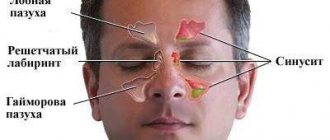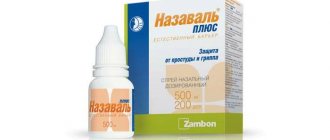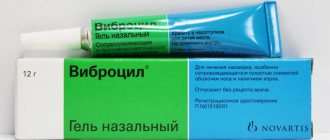Pharmacodynamics and pharmacokinetics
Morenasal is an isotonic sterile solution of natural sea salt diluted into an injection. water, contains trace elements and natural minerals. Its action is aimed at restoring natural nasal breathing, which is realized thanks to:
- Maintaining a physiologically normal state of the nasal mucosa, thinning mucus and normalizing its secretion in goblet cells.
- Removing allergens and pathogens, excess mucus, crusts and dust, tiny particles that clog the nasal passages, making breathing difficult (especially important in the postoperative period, as the risk of bleeding is reduced).
- The anti-inflammatory effect of the microelements that make up the drug activates restoration processes to improve the function of the ciliated epithelium and increase the resistance of the nasal mucosa to the attack of pathogenic bacteria and viruses, which promotes its natural cleansing.
- Removal of allergens, haptens, inhibition of the local inflammatory process (for example, with rhinitis of any origin, including allergic and vasomotor).
- Reducing discharge and swelling, which reduces the risk of otitis media and shortens the period of respiratory diseases.
- Isotonic drops and Morenazal spray do not cause pain in the sinuses compared to other hypertonic nasal solutions.
- The efficiency of using local drugs is increasing.
Pharmacokinetics
No information provided.
Medicinal properties
The active ingredient is sea salt. The nasal cavity is washed, irrigated and cleaned with the medicine. With the help of the drug Morenazal, breathing through the nose is restored, a runny nose is treated, and preventive manipulations are carried out to prevent infectious processes in the nasopharynx and nasal cavities. The mechanism of action of the product is simple: the saline solution helps wash away germs and viruses, and minerals and trace elements restore the protective functions of the internal tissue of the nose.
The medicine affects the diseased area as follows:
- returns and maintains its natural and healthy state
- thins and normalizes mucus production
- cleanses the nasal passages of allergens and pathogens
- washes away crusts, small particles - everything that prevents a person from breathing fully.
Thanks to the microelements and minerals of sea salt, it has an anti-inflammatory and moisturizing effect, the recovery processes are activated, the function of the ciliated epithelium is improved, and it in turn increases the resistance of the nasal mucosa to viruses and bacteria.
Indications for use
For nasal drops
- rhinitis, including acute, vasomotor and allergic;
- adenoids;
- chronic diseases of various locations: in the nasal cavity, nasopharynx, paranasal sinuses, which may be accompanied by dryness of the nasal mucosa;
- prevention of infectious processes in the nasal cavity during the cold season or in conditions of a changed climatic zone, for example, rooms with air conditioning and/or central heating, polluted atmospheric air (smoking, gas pollution from vehicles);
- preparation of the nasal cavity for the introduction and better absorption of other drugs;
- washing wounds, performing hygienic procedures for the nasal passages, incl. in the postoperative period.
For nasal spray
- symptomatic treatment of acute rhinitis;
- chronic, acute inflammatory processes occurring in the nasal cavity, sinuses and nasopharynx;
- rhinitis (infectious, allergic and atrophic), rhinosinusitis, nasopharyngitis;
- preparation of the nasal cavity for the introduction and better absorption of other drugs;
- used in pediatrics for adenoids;
- prevention of inflammation of the paranasal sinuses, for example, sinusitis, sinusitis;
- washing wounds, performing nasal hygiene procedures, incl. in the postoperative and autumn-winter period.
Analogs
Aqua Maris
, Croatia.
Price – 332 rubles.
A spray can containing the main active ingredient, sea water. Maintains the physiological state of the nasal cavities.
Pros:
- can be used by pregnant women
- contains only natural ingredients.
Minuses:
- some buyers note its high cost.
Aqualor
, Canada.
Price – 458 rubles.
Used to irrigate and wash the nose. Available in cylinders of 50 and 125 ml.
Pros:
- helps increase local immunity;
- regeneration of the nasal mucosa is accelerated when using the drug.
Minuses:
- sometimes sharp jet flow
- not suitable for children under 1 year of age.
Morenazal, instructions for use (Method and dosage)
The drug should be used intranasally, actively irrigating the nasal passages, rinsing and cleansing the nasal cavities.
Daily doses for treatment with nasal drops
- Children under 1 year: instill 1-2 drops into each nasal passage no more than 3 times.
- Children 1-7 years old - instill two drops into the nasal passages four times.
- Children 7-16 years old - two drops into the nasal passages 4-6 times.
- For adults, the dosage should not exceed 2-3 drops in each nasal passage 4 to 8 times.
- Course of treatment: 2-4 weeks, which can be repeated after one month.
Using nasal drops for hygienic purposes
Children under 1 year: instill 1-2 drops into the nasal passages 2-3 times.
In order to soften and remove excess nasal discharge, use the required number of drops, removing the fluid flowing from the nose with cotton swabs or tissues. The procedure can be repeated many times to completely liquefy and remove secretions accumulated in the nasal passages.
Using a nasal spray
Children 1 to 2 years of age: Lay your child down, turn their head to the side, and spray into the top nostril. Then sit the child down and clean the nose. Perform the procedure from the second nostril. Dosage:
- For treatment: 1 spray into each nostril 2-4 times a day is sufficient.
- As a hygiene measure: spray once into each nostril 1-2 times a day.
Adults and children over 2 years of age: tilt the head to the side and inject the drug directly into the upper nostril, wait 2-3 minutes and blow your nose. Repeat the procedure with the second nostril. Dosage:
- For treatment: age group 2-7 years - 2 injections into each nostril up to 4 times a day are sufficient; age group 7-16 years - up to six times a day; adults - 2-3 sprays into each nostril 4-8 times a day.
- As a hygiene measure: age group 2-7 years - should be sprayed 1-2 times into each nostril 1 to 3 times a day; age group 7-16 years - 2 times in each nostril 2-4 times a day; adults - inject 2-3 into each nostril 3-6 times a day.
Release forms
Price – 125 rubles for 20 ml, and 260 rubles for 50 ml.
On the official website, the manufacturer indicated that it is available only in the form of Morenasal spray. For this reason, drops are not available in any pharmacy.
Plastic bottles with a spray nozzle contain a colorless, odorless liquid that tastes salty. Bottles of 20 ml and 50 ml, sealed in cardboard packaging.
Available in three forms: “Morenazal”, “Morenazal IMMUNO”, “Morenazal with chamomile”.
special instructions
When using nasal drops, allergic reactions may develop.
When treating rhinitis, Morenasal can be combined with other medications.
The drug does not have a systemic effect.
Cases of overdose of the drug have not been reported to date.
No interaction of Morenazal with other drugs has been observed.
The drug can be used according to indications during pregnancy and breastfeeding.
Morenasal
Active substance:
Sea-water
Pharmgroup:
Anticongestants
Analogs for the active substance:Aqua Maris Aqua Maris plus Aqua Maris Strong Marimer Physiomer nasal spray Physiomer nasal spray for children Physiomer nasal spray forte Fluimarin | Application area:Abdominal surgery Adenomectomy Allergic rhinopathy Allergic rhinosinusopathy Allergic rhinosinusopathy Allergic rhinosinusopathy Allergic diseases of the upper respiratory tract Allergic respiratory diseases Allergic runny nose Allergic rhinitis Allergic rhinitis seasonal Allergic sinusitis Balloon coronary angioplasty Vaginal hysterectomy Vasomotor rhinitis Inhaled allergens Corona bypass Pain due to sinusitis Viral rhinitis Interventions on the vagina and cervix Bladder interventions Intervention in the oral cavity Exposure to harmful environmental factors Exposure to harmful environmental factors Impact of adverse environmental factors Impact of adverse environmental factors Exposure to adverse environmental conditions Impact of risk factors for the development of cardiovascular pathology Impact of physical factors Exposure to chemical factors Exposure to chemical factors Inflammation of the sinuses Inflammation of the nasopharynx Inflammation of the paranasal sinuses Inflammation of the nasal mucosa Inflammatory disease of the nose Inflammatory diseases of the paranasal sinuses Restorative and reconstructive operations Recovery period after surgery Sinusitis Acute sinusitis Hygiene of intimate areas of the body Hand hygiene of medical personnel Gynecological surgery Gynecological interventions Gynecological surgeries Hypertrophic rhinitis Hypovolemic shock during surgery Hypotensive reactions during weather changes Purulent-inflammatory processes of the paranasal sinuses Purulent sinusitis Purulent sinusitis Purulent rhinitis Disinfection of purulent wounds Disinfection of wound edges Diagnostic interventions Diagnostic procedures Diathermocoagulation of the cervix Long-term allergic rhinitis Long surgical operations Nasal congestion Nasal congestion due to colds and flu Replacing fistula catheters Difficulty in nasal breathing Difficulty in nasal breathing due to colds Difficulty in nasal breathing Difficulty in nasal breathing due to colds Infectious and inflammatory disease of ENT organs Infectious and inflammatory disease of ENT organs Infectious and inflammatory diseases of the ENT organs Infection during orthopedic surgery Sinus infection Artificial heart valve Catarrhal inflammation of the nasopharyngeal region Catarrhal inflammation of the nasopharyngeal region Catarrhal inflammation of the paranasal sinuses Catarrhal sinusitis Cystectomy Combined sinusitis Short-term outpatient surgery Short-term operations Short-term surgical procedures Cricothyroidotomy Blood loss during surgery Bleeding during surgery and in the postoperative period Year-round allergic rhinitis Year-round allergic rhinitis Year-round or seasonal allergic rhinitis Year-round rhinitis Year-round rhinitis of allergic nature Culdocentesis Laser coagulation Laser coagulation Laser coagulation of the retina Laparoscopy Laparoscopy in gynecology CSF fistula Lymphonodular pharyngitis Minor gynecological operations |







